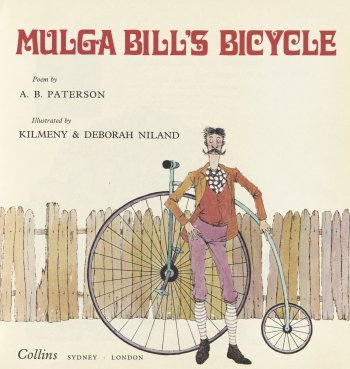‘Adults don't necessarily need to be reading storybooks to children, nor do they have to have children in their lives to benefit from these stories. Essentially, they belong to everyone.’
Curating the exhibition, Story Time: Australian Children’s Literature, gave me permission to revel in the world of children’s literature as an adult. I found myself reading a great deal of children’s literature and being surprised by how many stories I still cherished. I was even more surprised by how much I enjoyed reading new ones, for the first time since I was young.
One of my happiest moments was sitting in a reading room, trying to contain my laughter as I read Where Is the Green Sheep? and wondered why it had taken me this long to discover it. The rediscovery of books such as Hating Alison Ashley and Mulga Bill’s Bicycle was another highlight. Funnily enough, I appreciated these books even more through my adult eyes.
Image: Judy Horacek, Artwork for Where is the Green Sheep?, Written by Mem Fox, 2004, book published by Penguin, in Papers of Judy Horacek, nla.cat-vn4838339, reproduced by permission of Penguin Random House Australia Pty Ltd
Image: Deborah and Kilmeny Niland, Title Page of Mulga Bill’s Bicycle, Written by A.B. ‘Banjo’ Paterson, (Sydney: Collins, 1973), nla.cat-vn1715723Reading has always been a big part of my life. I was a child who spent a lot of time in the school library, had a full bookshelf and was always on the lookout for a new read. Books brought me pleasure, they taught me about people and the world. They were a source of great comfort during difficult times. Although reading remains a great pleasure of mine, my reading list has moved towards adult fiction and nonfiction over time. As I passed through adolescence and my twenties, I put down Seven Little Australians and The Eleventh Hour, moving on to more ‘mature’ Australian books such as Cloudstreet and The Slap.
Image: Ethel Turner, Seven Little Australians, (London; Melbourne: Ward, Lock and Bowden, 1894), nla.cat-vn2539508
Many adults share the same pleasure I found in children’s books. Jane Sullivan has written about her own experiences of revisiting much-loved children’s stories in her recent book Storytime: Growing Up with Books. As she re-read the favourite children’s books, she became interested in the lives of the authors who wrote them. At the end of Storytime she writes,
'Finding out about the authors of my favourite stories has given me a keener and sometimes more painful sense of appreciation for what they achieved. I think they worked their wonders not because they knew children well, but because in some sense they still were children'.
She adds ‘Reading these titles again has given me a keener and more painful sense of my child inside.’ Her experience mirrors my own.
Others have written about why they love children’s literature. Bruce Handy’s 2017 book Wild Things: The Joy of Reading Children’s Literature as an Adult recounts his journey of rediscovering children’s books, which happened when he became a parent. Handy writes glowingly of the genre: ‘Like any worthwhile art, great children’s books are capable of speaking in many different ways to many different readers’, including readers of different ages. His book provides a defence of children’s literature against critics who see it as inferior to adult books, or who simply overlook it.
More recently, Katherine Rundell penned an amusing and passionate essay Why You Should Read Children’s Books, Even Though You Are So Old and Wise in which she encourages all adults to read children’s books. Rundell argues ‘When you read children’s books, you are given the space to read again as a child’. She explains how these books provided her with a great sense of hope and that they still speak of it today. It is certainly something that struck me as I waded through countless children’s books while researching for Story Time. Rundell also makes a subtle and important point: adults do not necessarily need to be reading storybooks to little ones, nor must they have children in their lives to benefit from these stories. Essentially, they belong to everyone.
Curating Story Time was a surprising journey that involved becoming reacquainted with much loved characters from books I read as a child, and the meeting of new ones. Along the way, I rediscovered my love for children’s literature and have added many titles to my never-ending list of books I want to read. I hope visitors will have a similar experience. You have my permission to enter the magical, exciting and diverse world of children’s literature, not that you need it.


